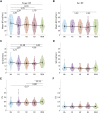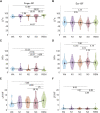Peripheral blood flow estimated by laser doppler flowmetry provides additional information about sleep state beyond that provided by pulse rate variability
- PMID: 36776965
- PMCID: PMC9908953
- DOI: 10.3389/fphys.2023.1040425
Peripheral blood flow estimated by laser doppler flowmetry provides additional information about sleep state beyond that provided by pulse rate variability
Abstract
Pulse rate variability (PRV), derived from Laser Doppler flowmetry (LDF) or photoplethysmography, has recently become widely used for sleep state assessment, although it cannot identify all the sleep stages. Peripheral blood flow (BF), also estimated by LDF, may be modulated by sleep stages; however, few studies have explored its potential for assessing sleep state. Thus, we aimed to investigate whether peripheral BF could provide information about sleep stages, and thus improve sleep state assessment. We performed electrocardiography and simultaneously recorded BF signals by LDF from the right-index finger and ear concha of 45 healthy participants (13 women; mean age, 22.5 ± 3.4 years) during one night of polysomnographic recording. Time- and frequency-domain parameters of peripheral BF, and time-domain, frequency-domain, and non-linear indices of PRV and heart rate variability (HRV) were calculated. Finger-BF parameters in the time and frequency domains provided information about different sleep stages, some of which (such as the difference between N1 and rapid eye movement sleep) were not revealed by finger-PRV. In addition, finger-PRV patterns and HRV patterns were similar for most parameters. Further, both finger- and ear-BF results showed 0.2-0.3 Hz oscillations that varied with sleep stages, with a significant increase in N3, suggesting a modulation of respiration within this frequency band. These results showed that peripheral BF could provide information for different sleep stages, some of which was complementary to the information provided by PRV. Furthermore, the combination of peripheral BF and PRV may be more advantageous than HRV alone in assessing sleep states and related autonomic nervous activity.
Keywords: autonomic nervous activity; blood flow; heart rate variability; pulse rate variability; respiration; sleep stages.
Copyright © 2023 Fan, Suzuki, Jiang, Okabe, Honda, Endo, Watanabe and Abe.
Conflict of interest statement
Authors SH, JE, and TW are employed by KYOCERA Corporation, Japan. The authors declare that this study received funding from KYOCERA Corporation. The funder had the following involvement in the study: study design and decision to publish. The remaining authors declare that the research was conducted in the absence of any commercial or financial relationships that could be construed as a potential conflict of interest.
Figures









Similar articles
-
Comparison between heart rate variability and pulse rate variability during different sleep stages for sleep apnea patients.Technol Health Care. 2017;25(3):435-445. doi: 10.3233/THC-161283. Technol Health Care. 2017. PMID: 27911348
-
Heart Rate Variability (HRV) and Pulse Rate Variability (PRV) for the Assessment of Autonomic Responses.Front Physiol. 2020 Jul 23;11:779. doi: 10.3389/fphys.2020.00779. eCollection 2020. Front Physiol. 2020. PMID: 32792970 Free PMC article.
-
Analysis of time-domain indices, frequency domain measures of heart rate variability derived from ECG waveform and pulse-wave-related HRV among overweight individuals: an observational study.F1000Res. 2023 Sep 27;12:1229. doi: 10.12688/f1000research.139283.1. eCollection 2023. F1000Res. 2023. PMID: 37799491 Free PMC article.
-
Heart Rate Variability and Multi-Site Pulse Rate Variability for the Assessment of Autonomic Responses to Whole-Body Cold Exposure.Annu Int Conf IEEE Eng Med Biol Soc. 2020 Jul;2020:2618-2621. doi: 10.1109/EMBC44109.2020.9175856. Annu Int Conf IEEE Eng Med Biol Soc. 2020. PMID: 33018543
-
Assessment of autonomic function by long-term heart rate variability: beyond the classical framework of LF and HF measurements.J Physiol Anthropol. 2021 Nov 30;40(1):21. doi: 10.1186/s40101-021-00272-y. J Physiol Anthropol. 2021. PMID: 34847967 Free PMC article. Review.
References
-
- Barnett W. H., Latash E. M., Capps R. A., Dick T. E., Wehrwein E. A., Molkov Y. I. (2020). Traube–Hering waves are formed by interaction of respiratory sinus arrhythmia and pulse pressure modulation in healthy men. J. Appl. Physiol. 129, 1193–1202. 10.1152/japplphysiol.00452.2020 - DOI - PMC - PubMed
LinkOut - more resources
Full Text Sources
Miscellaneous

